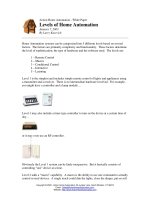Tài liệu Purpose of Public Speaking doc
Bạn đang xem bản rút gọn của tài liệu. Xem và tải ngay bản đầy đủ của tài liệu tại đây (672.99 KB, 6 trang )
1
Purpose of Public Speaking
Public Speaking will help the youth:
• acquire and relate subject matter knowledge
• learn to organize their ideas in a clear manner
• develop self-confidence about
their abilities and skills
• develop and display physical skills
• develop specific public speaking
skills
Public Speaking for Younger Youth
As a child begins to develop their public
speaking abilities emphasis should be on
gaining self-confidence and sharing with others. Encourage participation; don't push. Let
them see it is fun. Sometimes a reminder that show-n-tell is a form of a demonstration can be
reassuring.
In the beginning you will need to lead them through the steps in preparing an oral
presentation:
1) selecting a topic
2) researching the subject
3) collecting any necessary materials or equipment
4) organizing subject matter
5) writing the introduction and conclusion
6) presentation
Have youth answer these questions when selecting a topic to present. Can I do it in four to six
minutes? Am I interested in it? Is it a part of my project work? Is it useful to others? Does it
have enough action? Can I do it well? (See brochure - "Preparing My 4-H Presentation"). Be
sure that the topic is suitable for the member's interests and abilities.
Lit. 843
2
As the 4-Her begins to research the subject it is important that they choose viable sources
supported by research. This process teaches the child to become an educated and critical
consumer of reliable information and its source. Being able to site the source in the
presentation adds credibility to the information.
Encourage a lot of practice as a way of building confidence. Have them practice for teen
leaders, friends and family before presenting to their club members.
Public Speaking for Older Youth
When 4-H'ers are in their teens, you need to find different ways of working with them and
helping them to mature. Teenagers will require almost total freedom to plan and present their
demonstration/illustrated talk. Be available to coach and mentor upon request. Be aware that
inexperienced older youth will need more support and encouragement because they will want
to be with their peers.
Teenagers have definite ideas as to the direction they would like to take and will want to
choose their own subject and do most of the work independently. You can help best by asking
them some leading questions. "What is important to you - health education, environmental
issues, leisure activities, etc.? What special interests or concerns do you have? What have
you done in leadership projects or with youth as a teen leader?"
There are several types of public speaking suitable for teens. The older 4-H member could
show a key step in an involved process and use visual aids to show advantages and
disadvantages, cost, etc. Members might rely on visual aids alone to compress a job that took
weeks or even months to complete. The visuals may show why they planned the job, how it
was carried out and the results. If 4-H members want to show how to lead a discussion or
how to use buzz groups to get democratic action, they could demonstrate with people and use
charts or handouts to emphasize their points. This would be a simulation or direct experience
for the audience.
Teens should broaden their source of information beyond project manuals. You might suggest
the Internet, libraries, state or national associations, business people, research publications,
etc.
What is a 4-H Talk?
A 4-H talk/speech is one means of sharing information and educating an audience about a
specific subject. It is an oral presentation, in which the member does not rely on
posters/illustrations or objects. All illustrations are communicated through descriptions used in
the speech. Basically, the 4-H member paints a picture or tells a story through oral
communication.
What is a 4-H Illustrated Talk?
A 4-H illustrated talk is another means of sharing information and educating an audience about
a specific subject. It is an oral presentation, in which the member uses posters/illustrations or
objects to emphasize/illustrate specific points in the speech. A member does not actually make
or demonstrate how to do something in an illustrated talk.
What is a 4-H Demonstration?
A 4-H demonstration is a means of sharing information with an audience by showing them how
to do something. In this oral presentation the member shows how to make an item or complete
a task. When a demonstration is finished the 4-H member will have a finished product to show.
Helpful
Definitions
3
If youth are going to develop self-confidence, they need your support and encouragement. It
is important to let them know how pleased you are with their work. Make
suggestions for changes and improvements only after you have given
several good points about the presentation.
Youth should be encouraged to evaluate their own work, especially
in relation to how much they have improved from earlier efforts. Youth
with different abilities and experiences should not be judged against each
other. Let other youth offer suggestions, but first establish standards, such as,
"'Let's tell John what we liked best about his demonstration and then we will
offer suggestions for the next time he gives it." One or two suggestions may
be enough. Cut off any criticism which tears down the feeling of achievement
and acceptance.
Ask your county Extension office for a copy of the Public Speaking event scorecard that
judges use in scoring presentations. Before members give a talk demonstration/illustrated
talk, they may want to compare their presentations to the standards listed on the scorecard.
If you are a new volunteer, or if you would like ideas to use, Parent-Volunteer training
organized through the county Extension office or the 4-H Parent-Volunteer Association will be
a big help. Such programs assist you in helping the youth choose topics in line with their
interests and abilities, make outlines and organize their materials and carry out self-evaluation.
4-H members should use the local club or project group as a proving ground for their public
speaking. When youth feel they are ready, they should present the presentation to a wider
audience that might include a county 4-H audience, civic clubs, school and a community
group. Each time a club gives a presentation, they will improve and grow as a public speaker
and future community leader.
The trifold brochure and presentation outline can be of assistance when teach young people
how to organize their presentations.
•
Materials adapted from Sharing Resources for Project Leaders, Missouri Cooperative Extension Service, 1979.
Oklahoma State University, in compliance with Title VI and VII of the Civil Rights Act of 1964, Executive Order 11246 as amended, Title IX of the Education Amendments of 1972, Americans with Disabilities Act of 1990, and
other federal laws and regulations, does not discriminate on the basis of race, color, national origin, sex, age, religion, disability, or status as a veteran in any of its policies, practices or procedures. This includes but is not limited
to admissions, employment, financial aid, and educational service.
Issued in furtherance of Cooperative Extension work, acts of May 8 and June 30, 1914, in cooperation with the U.S. Department of Agriculture, Samuel Curl, Director of Cooperative Extension Service, Oklahoma State University, Stillwater, Oklahoma. This publication is issued
by Oklahoma State University as authorized by the Dean of the Division if Agricultural Sciences and Natural Resources and has been prepared for both internal and external distribution at a cost of $55.25 for 50 copies. 8/2001 BC.
Recognition and
Motivation
Help for the
Volunteer
The Audience
Handouts
4
4-H Presentation Outline
Topic/Subject__________________________________________
Introduction___________________________________________
______________________________________________________
__________________________________________________________________
Body - Outline
Point 1____________________________________________________________
__________________________________________________________________
__________________________________________________________________
__________________________________________________________________
Point 2____________________________________________________________
__________________________________________________________________
__________________________________________________________________
__________________________________________________________________
Point 3____________________________________________________________
__________________________________________________________________
__________________________________________________________________
__________________________________________________________________
Conclusion ________________________________________________________
__________________________________________________________________
Finalizing Your Presentation
After selecting the topic and preparing the body
of the presentation, outline the subject using key
words or concepts.
Outline the Presentation
I. Introduction
A. Opening - briefly tell what your
subject is and gain their attention by:
1. personal anecdote (story)
2. a startling statement or fact
3. a quote or poem
4. an appropriate joke or story
II. Body (The vital points of your
presentation)
A. Point 1 (past, present, and future)
B. Point 2 (problems, damages,
solutions)
C. Point 3 (Cause, Effect, Action
Needed)
III. Conclusion
A. Summary - brief
B. Closing - Appeal for action from
audience (give, join, support,
volunteer, change, do, etc.)
Practice using the outline. Use the outline to
remind you of the main points of your
presentation.
✰ Practice with family, friends, a video
camera, or tape recorder.
✰ A good presentation takes practice.
✰ Practice develops speaking skills and
personal confidence.
Resources:
4-H Communications Project Manuals Unit 1 and 2
Lit. 136 The Demonstration
Lit. 360 Helpful Hints for 4-H Talks
Fact Sheet T-8203 The Volunteer Teachers
Series: Do-It-Yourself Visuals
Selecting a Topic:
Choose a topic that:
• interests you
• you know something about
• suits your time limits
• you can research and write
about in the time available
to you
• will appeal to your audience
Choose a subject from
an area of interest:
• Hobby or spare time activity
• 4-H project or job you do
• Current events, activities or
world events
Do not ask yourself “What
should I talk about?” Instead,
ask...
a) Which one topic do I like
best?
b) Which would be the easiest
to research in terms of time
and resources available to
me?
c) Which would be hardest to
present and why?
d)
Which would be the most
fun for me and my
audience?
Remember: The more
strongly you feel about
the subject the better
the presentation will be.









